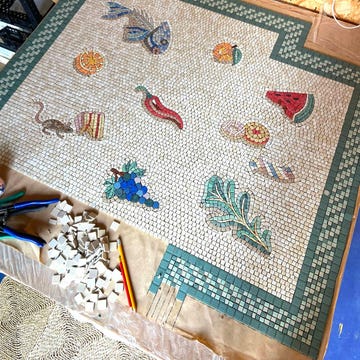Though the NHS recommends adults get between seven and nine hours of shut-eye a night, the reality is far starker. Statistics from a recent YouGov study show that as a nation, just a quarter are typically lucky enough to grab eight hours. If you’re reading this, chances are you’re doing so with droopy eyelids and a caffeinated drink within arm’s reach. So what can we do about it? We approached four people in the know to explain how our beds, bedding and accessories can impact the quality of our sleep.
The materials
If you’re someone who struggles with sleep, it might be worth trying bedding made from natural fibres such as cotton or linen. ‘Choosing materials that allow your body to regulate its temperature is proven to improve sleep, boosting health and wellbeing,’ explains Mark Tremlett, co-founder of Devon-based sustainable bed and mattress makers Naturalmat.
‘Materials such as organic wool are also naturally hypoallergenic, while organic coir, when layered with natural latex, offers a breathable layer of support.’ By contrast, synthetic fabrics can often soak up perspiration, which only increases the chances of restless sleep.
What's everyone reading?
While mattresses made from natural materials are often more expensive than synthetic or memory-foam alternatives, it makes economic sense to spend more on something that will last (Naturalmat’s latest release, the ‘Halstock’ bed, from £2,850, pictured, like the brand’s ‘Splendid’ mattress, £995, has a layer of recycled denim for sustainable cushioning). ‘Unlike synthetic options, natural fibres such as coir and latex are resilient and maintain their structure for longer,’ adds Tremlett, naturalmat.co.uk.
The mattress
Chad Eldridge, the sleep and wellbeing adviser at Swedish bed manufacturer Hästens, recommends: ‘Back sleepers need their lower back to have contact with the bed to keep it supported and in a neutral position, while side sleepers should consider whether their hips and shoulders are sinking into the mattress.’ Those who sleep on their stomach want enough tension underneath their torso so they can avoid being forced into a hyperextended position, which puts pressure on the spine.
He advises to ‘look for a bed with tension levels that can provide adequate support so that your body has contact with the mattress. It should not force you into restrictive positions.’ Buying a supportive bed (like the ‘2000T’, pictured, from £51,350) should go hand in hand with lifestyle changes too, he adds. ‘Set up a sleep routine that includes limiting activities that may agitate you or cause stress a couple of hours before bed,’ hastens.com.
The pillows
As chief executive officer of the 70-year-old, family-run Norwegian pillow and duvet brand Norvegr, it’s safe to say that Nils Stene knows a thing or two about sleep. The one piece of advice he gives to anyone in the market for a new pillow is to opt for natural materials. ‘Synthetics will make you sweat,’ he says. ‘Sustainable down is ideal because it’s nature’s most efficient insulator: it traps a lot of air that circulates evenly and regulates temperature and moisture. It is also naturally soft – the better the quality, the softer and plumper it will be. Increased fill power means bigger and denser down clusters, and a more luxurious feeling.’
Though this advice can be applied universally, he notes that your sleeping style also affects the pillow you’ll need (the ‘Standard’ collection, pictured, from £137, comes in varied thicknesses). ‘People who sleep on their back need medium support, while side-sleepers require their pillow to elevate the head so that the spine and neck stay in alignment, so a firm fill with a little give is good.’
Front-sleepers should look for a soft down pillow: ‘Sleeping on your front forces your cervical spine into a mild twist, so you’ll want something very thin that won’t lift your head and exacerbate the effects of that position,’ norvegr.com.


















